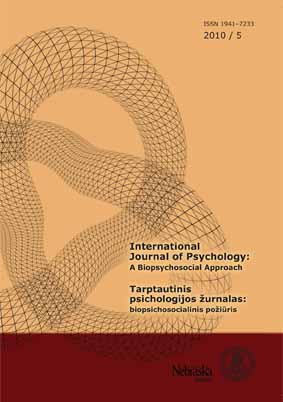Tranzityvių santykių ypatybių įtaka 4–6 amžiaus vaikų išvadoms
The Influence of Transitive Relation Specific Characteristics on Inferences Made by 4 To 6 Year-Old Children
Author(s): Indrė Vaidelienė, Vaclovas MartišiusSubject(s): Psychology
Published by: Vytauto Didžiojo Universitetas
Keywords: tranzityvios išvados; vizualiniai-erdviniai ir neerdviniai santykiai; ketverių– šešerių metų vaikai; transitive inferences; visual-spatial and non-spatial relations; 4 to 6-year-old children
Summary/Abstract: Problema. Straipsnis nagrinėja mažai tirtą problemą, kaip vaikų tranzityvumo supratimas priklauso nuo tranzityvių santykių ypatybių. Metodika. Pagrindinė tyrimo dalis buvo atlikta pagal P. E. Bryanto ir T. Trabasso (1971) naudotą metodiką. Papildomai vaikų buvo prašoma paaiškinti savo išvadas. Tyrimo tikslas – nustatyti tranzityvių santykių pobūdžio įtaką jaunų vaikų (4–6 metų) daromoms išvadoms. Kelta pagrindinė hipotezė, kad 4–6 metų vaikai dažniau teisingai įvertina vizualinio-erdvinio pobūdžio santykius tarp objektų, palyginti su neerdviniais santykiais. Rezultatai. Nustatyta, kad 4–6 metų vaikai daro mažiau klaidų, spręsdami vizualinio-erdvinio pobūdžio užduotis. Neerdvinių santykių užduotys vaikams yra daug sudėtingesnės. Spręsdami neerdvines užduotis, penkerių–šešerių metų vaikai nustato pagal nurodytas savybes objektų hierarchiją, t. y. geba sudaryti rangų skales, Inkaro efektu vaikų sprendimų paaiškinti negalima. Kebliau įvertinti, kas sąlygoja 4 metų vaikų išvadas. Jie dažniau spėja nei penkerių– šešerių metų vaikai.Tačiau teisingų–neteisingų atsakymų proporcijos 4–6 metų grupėse mažai skiriasi. Penkerių–šešerių metų vaikai dažniau nei ketverių aiškina savo atsakymus prasmingais argumentais. Background. The article focuses on an understudied problem regarding the influence of transitive relation specific characteristics on inferences made by 4 to 6 year-old children. Material and methods. The major part of the research has been conducted in accordance with the methodology employed by P. E. Bryant and T. Trabasso (1971). In addition, the children have been asked to explain their inferences. The aim of the study – to establish the influence of transitive relation character on inferences made by young children (aged from 4 to 6 years). The main hypothesis has been stated that 4 to 6 year-old children more frequently response properly when they are given for assessment the relations of visual-spatial character between the targets rather than those of non-spatial character. Results. It has been found that 4 to 6 year-old children make fewer mistakes when solving tasks of visual-spatial character. The tasks of non-spatial character appear to be much more complicated for children. When solving non-spatial tasks, children aged from 5 to 6 determine a hierarchy of targets according to the indicated characteristics, i.e., they manage to compose rankorder scales. Children’s inferences should not be explained by anchoring effect. It is more complicated to evaluate what causes the inferences drawn by 4-year-olds. They guess more frequently than children aged from 5 to 6 years. Still, the proportions of true-false responses in the groups of 4–6 years differ slightly. Children aged from 5 to 6 years explain their inferences making meaningful arguments more frequently than 4-year-olds.
Journal: Tarptautinis psichologijos žurnalas: biopsichosocialinis požiūris
- Issue Year: 2010
- Issue No: 5
- Page Range: 59-74
- Page Count: 16
- Language: Lithuanian

